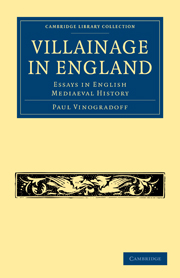Book contents
- Frontmatter
- PREFACE
- Contents
- INTRODUCTION
- FIRST ESSAY: THE PEASANTRY OF THE FEUDAL AGE
- SECOND ESSAY: THE MANOR AND THE VILLAGE COMMUNITY
- CHAPTER I THE OPEN FIELD SYSTEM AND THE HOLDINGS
- CHAPTER II RIGHTS OF COMMON
- CHAPTER III RURAL WORK AND RENTS
- CHAPTER IV THE LORD, HIS SERVANTS AND FREE TENANTS
- CHAPTER V THE MANORIAL COURTS
- CHAPTER VI THE MANOR AND THE VILLAGE COMMUNITY. CONCLUSIONS
- APPENDIX
- INDEX
CHAPTER IV - THE LORD, HIS SERVANTS AND FREE TENANTS
Published online by Cambridge University Press: 16 May 2011
- Frontmatter
- PREFACE
- Contents
- INTRODUCTION
- FIRST ESSAY: THE PEASANTRY OF THE FEUDAL AGE
- SECOND ESSAY: THE MANOR AND THE VILLAGE COMMUNITY
- CHAPTER I THE OPEN FIELD SYSTEM AND THE HOLDINGS
- CHAPTER II RIGHTS OF COMMON
- CHAPTER III RURAL WORK AND RENTS
- CHAPTER IV THE LORD, HIS SERVANTS AND FREE TENANTS
- CHAPTER V THE MANORIAL COURTS
- CHAPTER VI THE MANOR AND THE VILLAGE COMMUNITY. CONCLUSIONS
- APPENDIX
- INDEX
Summary
Medieval rural system
Descriptions of English rural arrangements in the age we are studying always suppose the country to be divided into manors, and each of these manors to consist of a central portion called the demesne, and of a cluster of holdings in different tributary relations to this central portion. Whether we take the Domesday Survey, or the Hundred Rolls, or the Custumal of some monastic institution, or the extent of lands belonging to some deceased lay lord, we shall again and again meet the same typical arrangement. I do not say that there are no instances swerving from this beaten track, and that other arrangements never appear in our records. Still the general system is found to be such as I have just mentioned, and a very peculiar system it is, equally different from the ancient latifundia or modern plantations cultivated by gangs of labourers working on a large scale and for distant markets, from peasant ownership scattered into small and self-dependent households, and even from the conjunction between great property and farms taken on lease and managed as separate units of cultivation.
The characteristic feature of the medieval system is the close connexion between the central and dominant part and the dependent bodies arranged around it. We have had occasion to speak in some detail of these tributary bodies—it is time to see how the lord's demesne which acted as their centre was constituted.
- Type
- Chapter
- Information
- Villainage in EnglandEssays in English Mediaeval History, pp. 313 - 353Publisher: Cambridge University PressPrint publication year: 2010First published in: 1892

